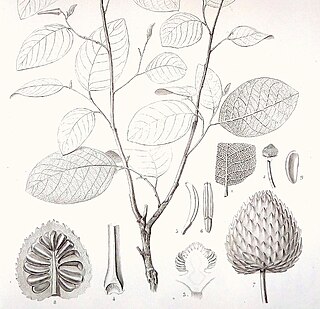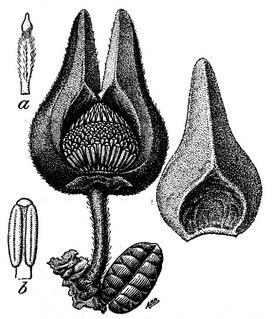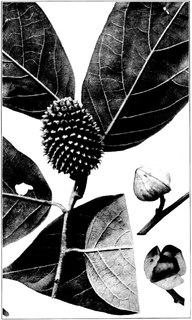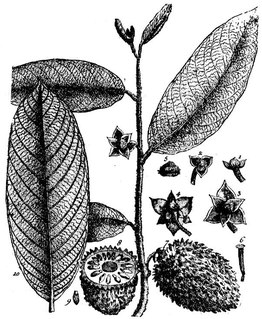
Annona sericea is a species of plant in the family Annonaceae. It is native to Bolivia, Brazil, Colombia, French Guiana, Guyana, Suriname, Trinidad-Tobago and Venezuela. Michel Félix Dunal, the French botanist who first formally described the species, named it after the silky hairs on its branches and leaves. In Brazil its common name is Aratincum do Para.

Annona acuminata is a species of plant in the Annonaceae family. It is native to Panama, and Colombia. William Edwin Safford, the American botanist who first formally described the species, named it after the tapering tips of its leaves.
Annona acutiflora is a species of plant in the Annonaceae family. It is native to Brazil. Carl Friedrich Philipp von Martius, the German botanist who first formally described the species, named it after the inner petals which come to a sharp point.
Annona angustifolia is a species of plant in the Annonaceae family. It is native to Brazil. Jacques Huber, the Swiss-Brazilian botanist who first formally described the species, named it after its narrow leaves.

Annona bullata is a species of plant in the family Annonaceae. It is native to Cuba. Achille Richard, the French botanist who first formally described the species, named it after the bubbled appearance of the spaces between the fine network of veins in the leaves.

Annona cascarilloides is a species of plant in the Annonaceae family. It is endemic to Cuba. According to William Edwin Safford, the species was named it after the pattern of its leaf veins which resemble species of a different genus, that at the time Safford was writing was called Cascarilla, but is now synonymous with the genera Croton and Ladenbergia. Despite this assertion by Safford, August Grisebach, the German botanist who first formally described the species, makes no mention of Cascarilla in his 1866 entry.

Annona jahnii is a species of plant in the family Annonaceae. It is native to the Brazil, Colombia and Venezuela. William Edwin Safford, the American botanist who first formally described the species, named it after the Venezuelan scientist, explorer and mountain climber Alfredo Jahn.

Annona macroprophyllata is a species of plant in the family Annonaceae. It is native to El Salvador, Guatemala, Honduras and Mexico. John Donnell Smith, the American botanist who first formally described the species, named it after its large leaves.

Annona nutans is a species of plant in the family Annonaceae. It is native to Argentina, Bolivia, Brazil and Paraguay. Robert Elias Fries, the Swedish botanist who first formally described the species, named it after its recurved peduncles which give the flowers a nodding appearance.

Annona paludosa is a species of plant in the family Annonaceae. It is native to Brazil, French Guiana, Guyana, Suriname and Venezuela. Jean Baptiste Christophore Fusée Aublet, the French pharmacist and botanist who first formally described the species, named it after its swampy habitat.
Annona sclerophylla is a species of plant in the family Annonaceae. It is native to Cuba. William Edwin Safford, the American botanist who first formally described the species, named it after its rigidly hard leaves.
Annona stenophylla is a species of plant in the family Annonaceae. It is native to Tanzania and Zambia. Adolf Engler and Ludwig Diels, the German botanists who first formally described the species, named it after its narrow leaves.

Cremastosperma cauliflorum is a species of plant in the family Annonaceae. It is native to Brazil, Colombia, Ecuador and Peru. Robert Elias Fries, the Swedish botanist who first formally described the species, named it after its flowers which grow from its main trunk or stem.

Fusaea longifolia is a species of plant in the family Annonaceae. It is native to Brazil, Colombia, Ecuador, French Guiana, Guyana, Peru, Suriname and Venezuela. Jean Baptiste Christophore Fusée Aublet, the French botanist who first formally described the species using the basionym Annona longifolia, named it after its long-leaved foliage.
Goniothalamus latestigma is a species of plant in the family Annonaceae. It is native to Myanmar and Thailand. Cecil Ernest Claude Fischer, the botanist who first formally described the species, named it after its broad stigmas.
Goniothalamus nitidus is a species of plant in the family Annonaceae. It is native to Borneo. Elmer Drew Merrill, the American botanist who first formally described the species, named it after its shining leaves.
Goniothalamus puncticulifolius is a species of plant in the family Annonaceae. It is native to Borneo and The Philippines. Elmer Drew Merrill, the American botanist who first formally described the species, named it after its minutely spotted leaves.
Annona haitiensis is a species of plant in the Annonaceae family. It is native to the Dominican Republic and Haiti. Robert Elias Fries, the Swedish botanist who first formally described the species, named it after Haiti where the specimen he examined was collected.
Annona moaensis is a species of plant in the family Annonaceae. It is endemic to Cuba. Frère León and Henri Alain Liogier, the botanists who first formally described the species, named it after Moa, Cuba where the specimen they observed was collected.
Duckeanthus is a genus of plant in the family Annonaceae. It is native to Brazil. It contains a single species, Duckeanthus grandiflorus. Robert Elias Fries, the Swedish botanist who first formally described it, named it in honor of Adolpho Ducke who collected the specimen he examined, and its large flowers.










